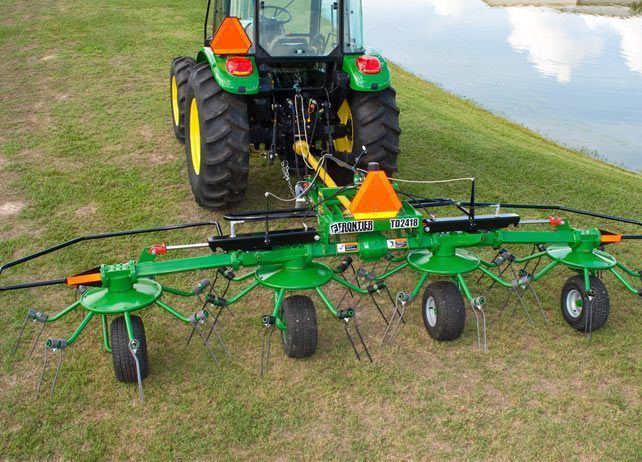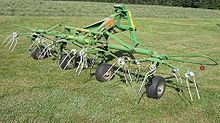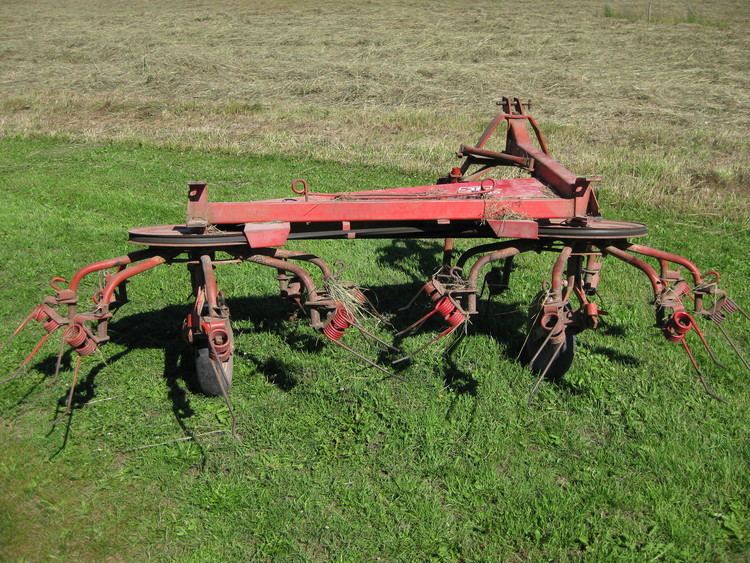 | ||
A tedder (also called hay tedder) is a machine used in haymaking. It is used after cutting and before windrowing, and uses moving forks to aerate or "wuffle" the hay and thus speed up the process of hay-making. The use of a tedder allows the hay to dry ("cure") better, which results in improved aroma and color.
Contents

History

The tedder came into use in the second half of the nineteenth century. While Charles Wendel claims in his Encyclopedia of American farm implements & antiques that the machine wasn't introduced to the United States until the 1880s, there are enough indications that the tedder was in use in the 1860s—The New York Times reports on its efficacy in 1868, and in that same year the Annual Report of the Commissioner of Agriculture in Maine comments on the American-made Hubbard's hay tedder, which had been on the market since 1863; according to the Maine report, in 1859 the machine was "an implement lately imported from England."

The action of the tedder is described, in the late 19th and early 20th century, as being used to "stir" or "scatter" cut hay in the field.
Operation
The original tedder is a farm tool on two wheels pulled by a horse; the rotation of the axle drives a gear which operates a "number of arms with wire tines or fingers at the lower ends." The tines pick up the hay and disperse it; usually, the height at which the tines pick up the hay can be adjusted.

In an early, simple hay tedder described in 1852 and manufactured in Edinburgh by the company of Mr. Slight, the two wheels, via a spur wheel and a pinion, drive a set of light wheels, the "rake wheels"; on these two rake wheels are mounted eight rakes, which pick up and disperse the hay. A later "English hay-tedder" uses two separate cylinders with rotating forks that can be reversed to lay the hay down lightly for improved exposure to air.
American machines, such as those made by Garfield, by Mudgett, and by Bullard (Ezekiel W. Bullard of Barre, Massachusetts, is credited in one source with the invention of the machine, nicknamed "the grasshopper"), typically used a system with a revolving crank in the middle of the arm and a lever at the upper end, or a system whereby rotating wheels moved the forks up and down. The first tedder widely available on the American market was the already mentioned Bullard's Hay Tedder, which had forks moving up and down on a compound crank, working in a motion described as "the energetic scratching of a hen." The American Hay Tedder, made by the Ames Plow Company of Boston and described in 1869 as a "new machine, remarkable for its simplicity and perfection of working, was more like the British machine in its rotational operation.
Some tedders have the rotating tines enclosed inside a solid structure to increase the force applied to the hay. Other similar machines included the wuffler and the acrobat. The wuffler shuffles the hay in a manner similar to the tedder. The acrobat may be used also for turning, and for rowing hay up ready for baling.
Centrifugal rakes
On two opposing horizontal gyroscopes, which are pto-driven, are mounted obliquely downward standing tines. These refer to the green waste and throw it back. Due to the rear-mounted collecting baskets a windrowing is as possible with a Rake. Their distribution is low because of the limited job performance.
Use and importance
Its development was of great importance to agriculture, since it saved labor and thus money: using a tedder, a man and a horse could do as much work as fifteen laborers. It also resulted in greater economy, since cut grass could be turned into hay the same day even if it had become wet or been trampled by horses and before its nutritional value could be reduced by repeated soaking from rain. Especially in humid areas (such as the Eastern United States), the invention of the tedder added greatly to improved hay production from such crops as alfalfa and clover, and allowed for haying while the grass was still green which produced hay of much higher value.
